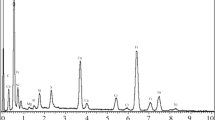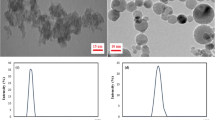Abstract
Nanofluids have been extensively applied in reservoirs to improve hydrocarbons recovery. An experimental investigation of nanofluids prepared with titanium dioxide nanoparticles with polyacrylamide at low salinity (NaCl 0.50 wt%) was conducted to study the value addition they bring to Enhanced Oil Recovery Process. Characterization was performed in terms of sedimentation, effect of pH, morphology with EDS, FTIR and XRD to better understand the nanofluids. The effect by varying concentrations of TiO2 was studied in brine solutions. Precisely, three different concentrations of nanoparticles (0.1, 0.20 and 0.30 wt%) were used in various brine solutions, under fixed salt concentration of 1.0 wt% each, whereas PAM (Polyacrylamide) polymer was utilized in concentrations of 0.10–0.40 wt%. The microstructure of TiO2 along with elemental analysis was performed. In addition, analytical techniques FTIR and XRD was performed to better understand the TiO2. Moreover, sedimentation was observed in all solutions, which mark sufficient time for sedimentation that was observed 72 h. In addition, effect of salt on pH, TDS and viscosity was analyzed. Optimized concentration of nanofluids (PAM 0.40 wt% and TiO2 0.20 wt%) was obtained for application in low salinity reservoirs.











Similar content being viewed by others
References
Agi A, Junin R, Shirazi R, Afeez G, Yekeen N (2018) Comparative study of ultrasound assisted water and surfactant flooding. J King Saud Univ Eng Sci, pp 1–8
Alagic E, Spildo K, Skauge S, Solbakken J (2011) Effect of crude oil ageing on low salinity and low salinity surfactant flooding. J Petrol Sci Eng 78:220–227
Alharbe L, El-Mossalamy EH, Arafa HM, Al-Owais A, Shah MA (2011) TiO2 nanoparticles with tetra-pad shape prepared by an economical and safe route at very low temperature. Applied Medical Science 5:130–135
Ali JA, Kolo K, Manshad AK, Mohammadi AJ (2018) Recent advances in application of nanotechnology in chemical enhanced oil recovery: Effect of nanoparticles on wettability alteration, interfacial tension reduction and flooding. Egypt J Pet 27:1371–1383
Antic Z, Krmanovic RM, Nikolic MG, Cincovic MM, Mitric M, Polizzi S, Dramicanin MD (2012) Multisite luminescence of rare earth doped TiO2 anatase nanoparticles. Mater Chem Phys 135:1064–1069
Behraminejad H, Manshad AK, Riazi M, Ali JA, Sajadi M, Keshavarz A (2019) CuO/TiO2/PAM as a Novel introduced hybrid agent for water-oil interfacial tension and wettability optimization in chemical enhanced oil recovery. Energy Fuels 33:10547–10560
Bizmark N, Ioannidis MA (2015) Effects of ionic strength on the colloidal stability and interfacial assembly of hydrophobic ethyl cellulose nanoparticles. Langmuir 31:9282–9289
Cabaleiro D, Gallego MJP, Gracia-Fernandez CA, Pineiro MM, Lugo L (2013) Rheological and volumetric properties of TiO2 ethylene-glycol nanofluid. Nanoscale Res Lett, p 286
Chougala LS, Yatnatti MS, Linganagoudar RK, Kamble RR, Kadadevarmath JS (2017) A simple approach on synthesis of TiO2 nanoparticles and its application in dye sensitized solar cells. J Nano- Electronic Phys 9:6
Corredor-Rojas LM, Hemmati-Sarapardeh A, Husein MM, Dong M, Maini BB (2018) Rheological behavior of surface modified silica nanoparticles dispersed in partially hydrolyzed polyacrylamide and Xanthangum solutions: experimental measurements, mechanistic understanding, and model development. Energy Fuels 32:10628–10638
Fal J, Sobczak J, Stagraczynski R, Estelle P, Zyla G (2022) Electrical conductivity of titanium dioxide ethylene glycol-based nanofluids: impact of nanoparticles phase and concentration. Powder Technol 404:117423
Gbadamosi AO, Junin R, Manan MA, Agi A, Yusuff AS (2019a) An overview of 548 chemical enhanced oil recovery: recent advances and prospects. Int Nano Lett 549:1–32. https://doi.org/10.1007/s40089-019-0272-8
Gbadamosi AQ, Junin R, Manan MA, Yekeen N, Augustine A (2019) Hybrid suspension of polymer and nanoparticles for enhanced oil recovery. Poly Bull, pp 1–38.
Guo K, Li H, Yu Z (2016) In-situ heavy and extra-heavy oil recovery: a review. Fuel 185:886–902
Huang J, Wang X, Long Q, Wen X, Zhoun Y, Li L (2009) Influence of pH on the stability characteristics of nanofluids. In: IEEE Symposium Photonics and Optoelectronics.
John BF, Sharfudeen M, Latheef AFA, Ambrose RV (2017) Synthesis and characterization of TiO2 nanoparticles and investigations of antimicro activities against human pathogens. J Pharma Sci Res 9:1604–1608
Juarez JL, Bertin H, Omari A, Romero C, Bourdarot G, Jouenne S, Morel D, Neillo V (2020) Polymer injection for EOR: Influence of mobility ratio and slug size on final oil recovery. SPE-200611-MS
Karg M, Pich A, Hellweg T et al (2019) Nanogels and microgels: from model colloids to applications, recent developments, and future trends. Am Langmuir Soc 35:6231–6255
Khan MB, Khoker MF, Hussian M, Ahmed M, Anwer S (2018) Effects of nanoparticles on rheological behavior of polyacrylamide related to enhance oil recovery. Acad J Polym Sci 1:555573
Khoramian R, Kharrat R, Golshokooh S (2022) The development of ovel nanofluid for enhanced oil recovery application. Fuel 311:122558
Kindi SA, Bahry SA, Wahaiba YA, Taura U, Joshi S (2022) Partially hydrolyzed polyacrylamide: enhanced oil recovery applications, oil-field produced water pollution, and possible solutions. Environ Monit Assess 194:875
Kumar A, Mandal A (2017) Synthesis and physiochemical characterization of zwiterrionic surfactant for application in enhanced oil recovery. J Molec Liquids 243:61–71
Li R, Li T, Zhou Q (2020) Impact of titanium dioxide (TiO2) modification on its application to pollution treatment—a review. Catalysts, 804.
Nandiyanto ABD, Oktiani R, Ragadhita R (2019) How to read and interpret FTIR Spectroscope of organic material. Indonesian J Sci Technol, pp 97–118
Ogiriki SO, Agunloye MA, Gbadamosi AO, Olafuyi AO (2016) Exploitation of bitumen from Nigerian Tar Sand Using Hot-Water/steam stimulation process. Pet Coal 58:07–413
Panchal H, Patel H, Patel J, Shah M (2021) A systematic review on nanotechnology in enhanced oil recovery. Petrole Res h 6:204–212
Parizad AH, Ghahforakhi AK, Shahbazi K, Daryasafar A, Sayahi T, Meybodi MK (2019) Experimental investigation of the effect of TiO2 nanofluid and KCl salt om polymeric water based drilling fluid properties. Oil Gas Sci Technol 74:9
Pereira MLDO, Maia KCB, Silva WC, Leite AC, Francisco ADDS, Vasconcelos TL, Nascimento SV, Grassechi D (2020) Fe3O4 nanoparticles as surfactant carriers for enhanced oil recovery and scale prevention. ACS Publication 3:5762–5772
Pope GA (2011) Recent developments and remaining challenges of enhanced oil recovery. J Pet Sci. SPE-0711–0065-JPT, pp 65–68
Rezvani H, Khalilnezhad A, Ganji P et al (2018) How ZrO2 nanoparticles improved the oil recovery by affecting the interfacial phenomena in the reservoir conditions. J Molec Liquids 252:158–168
Roy A, Kabra D, Pareek G, Kumari K, Kashyap PP, Naik S, Chadha U, Selvaraj SK (2023) A review of nanomaterials and their applications in oil and petroleum industries. Nano Express, pp 022002.
Saboorian-Jooybari H, Dejam M, Chen Z (2016) Heavy oil polymer flooding from 545 laboratory core floods to pilot tests and field applications: half-century studies. J Pet Sci Eng 142:85–100. https://doi.org/10.1016/j.petrol.2016.01.023. 547
Sadeghalvaad M, Sabbaghi S (2015) The effect of the TiO2/Polyacrylamide nanocomposites on water based drilling fluid properties. Powder Technol 272:113–119
Sagbana PI, Abushaikha AS (2021) A comprehensive review of the chemical-based conformance control methods in oil reservoirs. J Petrol Explor Prod Technol 11:2233–2257
Sun X, Zhang Y, Chen G, Gai Z (2017) Application of nanoparticles in enhanced oil recovery: a critical review of recent progress. Energies 10:345
Toro RG, Diab M, Caro TD, Shemy MA, Adel A, Caschera D (2020) Study of the effect of Titanium dioxide hydrosol on the photocatalytic and mechanical properties of paper sheets. Material, 13061326
Wang D, Liu F, Li G, He S, Song K, Zhang J (2023) Characterization and dynamic adjustment of the flow fluid during the late stage of water flooding in strongly heterogeneous reservoirs. Energies, p 831
Wu H, Ge J, Yang L, Zhang T, Liu M, Guo H (2022a) New insight into the rheological and fracture properties of PAM gels: Effects of entanglements. J Petrol Sci Eng 212:110260
Wu A, Zhao X, Yang C, Wang J, Wang X, Liang W, Zhou L, Teng M, Niu L, Tang Z, Hou G, Wu F (2022b) A comparative study on aggregation and sedimentation of natural geothite and artificial Fe3O4 nanoparticles in synthetic and natural water based on extended Derjaguin-Landau-Verwey-Overbeek (XDLVO) theory and molecular dynamics simulation. J Hazard Mater 435:128876
Yekeen N, Manan MA, Idris AK et al (2018) A comprehensive review of experimental studies of nanoparticles-stabilized foam for enhanced oil recovery. J Petrol Sci Eng 164:43–74
Zhang H, Qing S, Zhai Y, Zhang X, Zhang A (2021) The changes induced by TiO2/water nanofluids: stability, thermophysical properties and thermal performance. Powder Technol, pp 748–759
Funding
This is a self-funded project.
Author information
Authors and Affiliations
Corresponding author
Ethics declarations
Conflict of interest
The author declares that there is no conflict of interest between the co-authors.
Additional information
Publisher’s Note
Springer Nature remains neutral with regard to jurisdictional claims in published maps and institutional affiliations.
Rights and permissions
Springer Nature or its licensor (e.g. a society or other partner) holds exclusive rights to this article under a publishing agreement with the author(s) or other rightsholder(s); author self-archiving of the accepted manuscript version of this article is solely governed by the terms of such publishing agreement and applicable law.
About this article
Cite this article
Lashari, Z.A., Lalji, S.M., Ali, S.I. et al. Physiochemical analysis of titanium dioxide and polyacrylamide nanofluid for enhanced oil recovery at low salinity. Chem. Pap. 78, 3629–3637 (2024). https://doi.org/10.1007/s11696-024-03334-4
Received:
Accepted:
Published:
Issue Date:
DOI: https://doi.org/10.1007/s11696-024-03334-4




